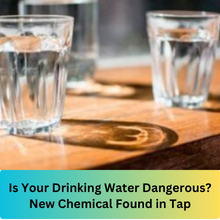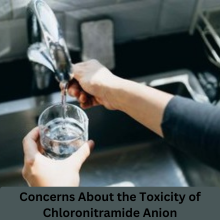
A recent study has revealed the identification of a chemical byproduct, previously unknown, in U.S. tap water. This discovery has sparked significant concern among scientists, as this chemical may be toxic. While it’s only been identified recently, this chemical has been present in many homes across the United States for decades. The substance, called chloronitramide anion, is produced when chloramine, a common disinfectant used in water treatment, breaks down over time. Scientists are now working to determine whether this chemical could pose a threat to public health.
Understanding Chloramine and Its Role in Water Treatment
Chloramine is a chemical used to disinfect drinking water. It’s created by combining chlorine with ammonia, and it’s widely used in municipal water systems across the country. Chloramine is favored by many water utilities because it doesn’t produce the same harmful byproducts as chlorine, such as trihalomethanes, which have been linked to certain types of cancer.
The role of chloramine in water treatment is essential: it kills harmful bacteria and viruses that could otherwise make people sick. But, while chloramine has benefits in making water safer, its presence in drinking water can lead to the formation of other chemicals, some of which have remained undetected—until now.
The Newly Identified Chemical: Chloronitramide Anion
The chemical recently identified is chloronitramide anion. This substance forms when chloramine decomposes over time, likely occurring in drinking water that has been treated with chloramine. Researchers have discovered this chemical in drinking water systems across the United States.
The substance was first detected 40 years ago, but it was only now that scientists were able to identify it definitively. Thanks to advances in analytical techniques, the structure of chloronitramide anion has been revealed, enabling researchers to better understand its potential health effects.
The Ubiquity of Chloronitramide Anion in U.S. Tap Water
The recent study found that chloronitramide anion is likely present in the drinking water of approximately 113 million Americans. It was detected in all 40 samples of water collected from 10 different U.S. states. This finding suggests that the chemical is widespread and could potentially be found in millions of homes that rely on chloramine-treated water.
Despite this widespread presence, scientists are still uncertain about the health risks posed by chloronitramide anion. The chemical has never been studied extensively before, and its full effects on human health are unknown.
Concerns About the Toxicity of Chloronitramide Anion
Given that chloronitramide anion is a byproduct of a widely used water disinfectant, many experts are concerned about its potential toxicity. While there’s no direct evidence linking chloronitramide anion to specific health problems, it shares structural similarities with other toxic chemicals.
This has led scientists to raise alarms about the possible risks of prolonged exposure to chloronitramide anion, particularly since it’s found in such high concentrations in treated water across the country. The main question now is: Could this chemical be harmful to human health?
What Makes Chloronitramide Anion Different?
Chloronitramide anion is considered to be a small, reactive molecule, which means it could easily enter biological systems and interact with cells. This property makes it different from other water treatment byproducts, which are often larger and less reactive. Given these characteristics, scientists worry that chloronitramide anion might have the potential to cause harm to human health.
Furthermore, because this chemical has never been studied before, its full biological impact remains a mystery. The concerns are heightened by the fact that it’s found in tap water across the nation, making it a widespread concern.
Current State of Research: What We Know and What We Don’t
While scientists now know the chemical structure of chloronitramide anion, much remains uncertain. The identification of the chemical has only recently been made possible due to advancements in testing methods. However, research into its toxicity is still in its early stages. As of now, there is no definitive evidence suggesting that chloronitramide anion poses an immediate danger.
What is clear, though, is that the presence of this substance in such widespread water systems requires closer scrutiny. Further research is needed to understand the full scope of potential risks, and it could take years before scientists can conclude whether this chemical is harmful or not.
The Broader Context: The Health Risks of Disinfected Water
Chloronitramide anion is part of a much broader conversation about the health risks associated with disinfected water. Many studies have suggested links between drinking disinfected water and an increased risk of certain cancers, including bladder cancer. Other studies have pointed to potential risks of miscarriage and birth defects in communities with high levels of disinfectant byproducts.
As a result, there is growing concern about the long-term health effects of drinking water treated with chemicals like chloramine and chlorine. This new discovery adds to the ongoing debate about the safety of municipal water systems and the chemicals used to disinfect them.
The Debate Over Chloramine vs. Chlorine
Chloramine has become increasingly popular in water treatment due to its ability to persist in water systems and provide long-lasting disinfection. Unlike chlorine, which breaks down relatively quickly, chloramine continues to disinfect water even as it travels through pipes. This makes chloramine a preferred option for maintaining water quality.
However, the debate over chloramine vs. chlorine is far from over. Chlorine has its own set of risks, including the formation of harmful byproducts like trihalomethanes, which have been linked to cancer. But chloramine’s potential dangers, as highlighted by the discovery of chloronitramide anion, may be even more concerning.
Also read: Snowstorm Forces School Closures on Nov 22 – Check Now
Potential Regulatory Implications
The discovery of chloronitramide anion is likely to prompt a reassessment of water treatment regulations in the U.S. Currently, the Environmental Protection Agency (EPA) regulates only a small number of disinfectant byproducts, mainly those produced by chlorine. The discovery of this new chemical could lead to the inclusion of chloramine-related byproducts in future regulations.
However, the process of updating regulations is slow, and it could take years before any changes are made. Even if further research shows that chloronitramide anion is harmful, it could be many more years before any action is taken to limit exposure or regulate its presence in drinking water.
The Role of Water Utilities in Addressing New Concerns
As more research is conducted into chloronitramide anion and other disinfectant byproducts, water utilities will need to stay informed and adapt accordingly. While it’s difficult to make definitive recommendations without knowing the full risks of chloronitramide anion, utilities can take steps to minimize exposure by using alternative disinfection methods or improving water treatment processes.
In the meantime, homeowners may want to consider installing water filters that can remove disinfectant byproducts from their drinking water. Activated carbon filters, for example, have been shown to reduce the levels of chloramine and its byproducts, though more research is needed to confirm their effectiveness.
Moving Forward: What Needs to Be Done?
The discovery of chloronitramide anion is just the beginning of what could be a long process of research and regulation. There is still much to learn about the chemical, its potential toxicity, and its long-term health effects. But the identification of this substance has already sparked a much-needed conversation about the safety of the chemicals used to treat tap water.
As research continues, it will be crucial for scientists, regulators, and water utilities to work together to ensure that drinking water remains safe for all Americans. While the full risks of chloronitramide anion remain unknown, the discovery serves as a reminder of the need for ongoing vigilance in water safety.
Also read: Retirement Home Crime Solved? Discover ‘A Man on the Inside’ Mystery
Conclusion
The identification of chloronitramide anion is an important development in the field of water safety. While its potential toxicity remains unclear, its widespread presence in U.S. tap water raises concerns that need to be addressed. As research continues, it is essential that both regulators and water utilities stay ahead of potential risks to ensure that drinking water remains safe for everyone.
FAQs
What is chloronitramide anion?
Chloronitramide anion is a chemical byproduct formed when chloramine, used to disinfect drinking water, breaks down over time.
How is chloramine used in water treatment?
Chloramine is formed by combining chlorine and ammonia and is used to disinfect drinking water, killing harmful bacteria and viruses.
Can chloronitramide anion cause health problems?
The toxicity of chloronitramide anion is still unknown, but scientists are concerned about its potential risks due to its reactivity and presence in drinking water systems.
How do I know if my tap water contains chloramine?
Check with your local water utility. Many utilities disclose whether they use chloramine or chlorine for water treatment on their websites.
What can be done to remove chloramine from drinking water?
Activated carbon filters are known to reduce the presence of chloramine and its byproducts, but more research is needed to determine their effectiveness.

